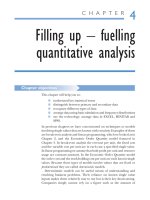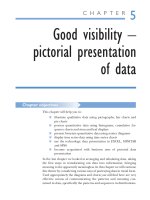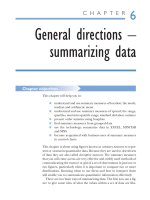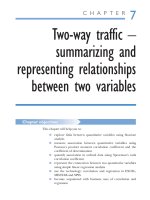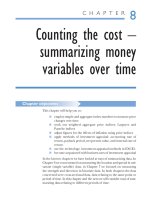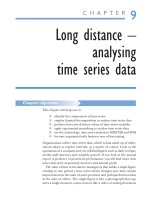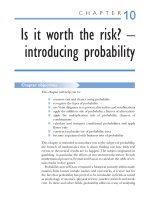Research methods for business 5th ch7
Bạn đang xem bản rút gọn của tài liệu. Xem và tải ngay bản đầy đủ của tài liệu tại đây (1.27 MB, 88 trang )
Slide 7.1
Chapter 7
Selecting Samples
Saunders, Lewis and Thornhill, Research Methods for Business Students, 5th Edition, © Mark Saunders, Philip Lewis and Adrian Thornhill 2009
Slide 7.2
Saunders, Lewis and Thornhill, Research Methods for Business Students, 5th Edition, © Mark Saunders, Philip Lewis and Adrian Thornhill 2009
Slide 7.3
Saunders, Lewis and Thornhill, Research Methods for Business Students, 5th Edition, © Mark Saunders, Philip Lewis and Adrian Thornhill 2009
Slide 7.4
Saunders, Lewis and Thornhill, Research Methods for Business Students, 5th Edition, © Mark Saunders, Philip Lewis and Adrian Thornhill 2009
Slide 7.5
Selecting samples
Population, sample and individual cases
Source: Saunders et al. (2009)
Figure 7.1 Population, sample and individual cases
Saunders, Lewis and Thornhill, Research Methods for Business Students, 5th Edition, © Mark Saunders, Philip Lewis and Adrian Thornhill 2009
Slide 7.6
The need to sample
Sampling- a valid alternative to a census when
• A survey of the entire population is
impracticable
• Budget constraints restrict data collection
• Time constraints restrict data collection
• Results from data collection are needed quickly
Saunders, Lewis and Thornhill, Research Methods for Business Students, 5th Edition, © Mark Saunders, Philip Lewis and Adrian Thornhill 2009
Slide 7.7
Saunders, Lewis and Thornhill, Research Methods for Business Students, 5th Edition, © Mark Saunders, Philip Lewis and Adrian Thornhill 2009
Slide 7.8
Overview of sampling techniques
Sampling techniques
Figure 7.2 Sampling techniques
Source: Saunders et al. (2009)
Saunders, Lewis and Thornhill, Research Methods for Business Students, 5th Edition, © Mark Saunders, Philip Lewis and Adrian Thornhill 2009
Slide 7.9
The sampling frame
• The sampling frame for any probability
sample is a complete list of all the cases in
the population from which your sample will
be drown.
Saunders, Lewis and Thornhill, Research Methods for Business Students, 5th Edition, © Mark Saunders, Philip Lewis and Adrian Thornhill 2009
Slide 7.10
Saunders, Lewis and Thornhill, Research Methods for Business Students, 5th Edition, © Mark Saunders, Philip Lewis and Adrian Thornhill 2009
Slide 7.11
Probability sampling
The four stage process
1. Identify sampling frame from research
objectives
2. Decide on a suitable sample size
3. Select the appropriate technique and the
sample
4. Check that the sample is representative
Saunders, Lewis and Thornhill, Research Methods for Business Students, 5th Edition, © Mark Saunders, Philip Lewis and Adrian Thornhill 2009
Slide 7.12
Saunders, Lewis and Thornhill, Research Methods for Business Students, 5th Edition, © Mark Saunders, Philip Lewis and Adrian Thornhill 2009
Slide 7.13
Identifying a suitable sampling frame
Key points to consider
• Problems of using existing databases
• Extent of possible generalisation from the
sample
• Validity and reliability
• Avoidance of bias
Saunders, Lewis and Thornhill, Research Methods for Business Students, 5th Edition, © Mark Saunders, Philip Lewis and Adrian Thornhill 2009
Slide 7.14
Sample size
Choice of sample size is influenced by
• Confidence needed in the data
• Margin of error that can be tolerated
• Types of analyses to be undertaken
• Size of the sample population and distribution
Saunders, Lewis and Thornhill, Research Methods for Business Students, 5th Edition, © Mark Saunders, Philip Lewis and Adrian Thornhill 2009
Slide 7.15
Saunders, Lewis and Thornhill, Research Methods for Business Students, 5th Edition, © Mark Saunders, Philip Lewis and Adrian Thornhill 2009
Slide 7.16
Saunders, Lewis and Thornhill, Research Methods for Business Students, 5th Edition, © Mark Saunders, Philip Lewis and Adrian Thornhill 2009
Slide 7.17
Saunders, Lewis and Thornhill, Research Methods for Business Students, 5th Edition, © Mark Saunders, Philip Lewis and Adrian Thornhill 2009
Slide 7.18
Saunders, Lewis and Thornhill, Research Methods for Business Students, 5th Edition, © Mark Saunders, Philip Lewis and Adrian Thornhill 2009
Slide 7.19
Saunders, Lewis and Thornhill, Research Methods for Business Students, 5th Edition, © Mark Saunders, Philip Lewis and Adrian Thornhill 2009
Slide 7.20
Saunders, Lewis and Thornhill, Research Methods for Business Students, 5th Edition, © Mark Saunders, Philip Lewis and Adrian Thornhill 2009
Slide 7.21
Saunders, Lewis and Thornhill, Research Methods for Business Students, 5th Edition, © Mark Saunders, Philip Lewis and Adrian Thornhill 2009
Slide 7.22
Saunders, Lewis and Thornhill, Research Methods for Business Students, 5th Edition, © Mark Saunders, Philip Lewis and Adrian Thornhill 2009
Slide 7.23
Saunders, Lewis and Thornhill, Research Methods for Business Students, 5th Edition, © Mark Saunders, Philip Lewis and Adrian Thornhill 2009
Slide 7.24
Saunders, Lewis and Thornhill, Research Methods for Business Students, 5th Edition, © Mark Saunders, Philip Lewis and Adrian Thornhill 2009
Slide 7.25
Saunders, Lewis and Thornhill, Research Methods for Business Students, 5th Edition, © Mark Saunders, Philip Lewis and Adrian Thornhill 2009



